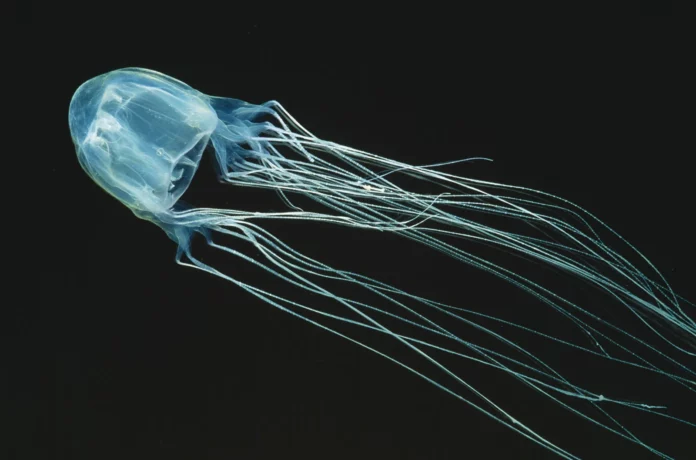Jellyfish are fascinating sea creatures, but some of them can be very dangerous. One of the most poisonous jellyfish in the world is the Box Jellyfish. Found mainly in the waters of the Pacific and Indian Oceans, this jellyfish is known for its deadly sting. Let’s explore some interesting facts about this fearsome marine animal.
Why it’s called Box Jellyfish?
The Box Jellyfish gets its name from its distinctive shape. Unlike the more common bell-shaped jellyfish, the Box Jellyfish has a cube-like, or box-shaped, body. This unique shape sets it apart from other jellyfish species and contributes to its name. Here are some additional details:
- Distinctive Shape: The Box Jellyfish has a square or cube-shaped bell, with four distinct sides, giving it a box-like appearance. This shape is quite different from the more rounded or dome-shaped bodies of other jellyfish species.
- Scientific Name: The scientific name for the Box Jellyfish is “Chironex fleckeri,” which refers to its classification within the Cubozoa class. The term “Cubozoa” comes from the Latin word “cubus,” meaning cube, further emphasizing the jellyfish’s box-like structure.
Deadly Tentacles
The tentacles of the Box Jellyfish can grow up to 10 feet (3 meters) long and are covered in thousands of tiny, stinging cells called nematocysts. When these cells come into contact with skin, they release venom that can cause severe pain, paralysis, and even death within minutes.
Where They Live
Box Jellyfish are typically found in the warm coastal waters of the Pacific and Indian Oceans, especially around northern Australia. They prefer shallow waters and can often be found near beaches, making them a significant threat to swimmers.
Venom and Effects
The venom of a Box Jellyfish is considered one of the most powerful in the animal kingdom. It attacks the heart, nervous system, and skin cells. A sting can cause extreme pain, nausea, and difficulty breathing. In severe cases, it can lead to cardiac arrest and death within minutes if not treated promptly.
First Aid and Treatment
Immediate treatment is crucial if stung by a Box Jellyfish. The first step is to pour vinegar on the sting area to neutralize the venom. Removing the tentacles with a stick or tweezers is also important. Seeking medical attention as quickly as possible is essential to manage the severe symptoms and prevent death.
- Rapid Onset of Symptoms: One of the most alarming aspects of a Box Jellyfish sting is the rapid onset of symptoms. Within minutes, victims can experience intense pain, difficulty breathing, and heart problems. This rapid reaction requires immediate medical attention to prevent severe complications or death.
- Life-Saving Vinegar: In areas where Box Jellyfish are common, such as Northern Australia, many beaches are equipped with vinegar stations. Vinegar is used to neutralize the jellyfish’s nematocysts, preventing them from releasing more venom. Applying vinegar to the sting site is a crucial first aid step before seeking medical help.
- Fatalities and Near Misses: Box Jellyfish stings have caused several fatalities, primarily in Australia and Southeast Asia. However, there are also numerous cases of near misses where prompt medical intervention saved lives. For instance, in 2006, a 10-year-old girl in Queensland, Australia, survived a severe sting thanks to the quick application of vinegar and cardiopulmonary resuscitation (CPR) performed by lifeguards.
- Innovative Treatments: Researchers and medical professionals are constantly developing new treatments to combat the effects of Box Jellyfish stings. One promising approach involves using a spray derived from a protein found in the tentacles of sea anemones, which can neutralize the venom and provide relief from pain and inflammation.
- Protective Measures: To reduce the risk of stings, swimmers in Box Jellyfish-infested waters are advised to wear protective clothing, such as stinger suits, which cover most of the body and prevent contact with the jellyfish’s tentacles. Some beaches also have stinger nets installed to create safer swimming areas.
Interesting Facts about Box Jellyfish:
- Shape and Movement: Unlike most jellyfish, the Box Jellyfish has a cube-shaped bell that allows it to move more efficiently through the water.
- Eyes: The Box Jellyfish has 24 eyes, which help it navigate and hunt for prey.
- Lifespan: Box Jellyfish typically live for about a year in the wild.
- Size: While their tentacles can reach up to 10 feet, the bell itself is usually around 8 inches (20 cm) in diameter.
- Speed: These jellyfish can swim at speeds of up to 4 knots, making them one of the fastest jellyfish species.
- Avoidance: Box Jellyfish are often active during the warmer months and tend to avoid cooler waters.
Fascination and Fear
The Box Jellyfish continues to intrigue and terrify people around the world. Its deadly sting and unique characteristics make it a subject of fascination for scientists and marine enthusiasts. While it’s important to respect and be cautious of these creatures, understanding more about them can help reduce fear and promote safety.
The Box Jellyfish, with its potent venom and striking appearance, remains one of the most remarkable and feared inhabitants of the ocean. By learning about and respecting these incredible animals, we can appreciate the complexity and beauty of our marine world.
